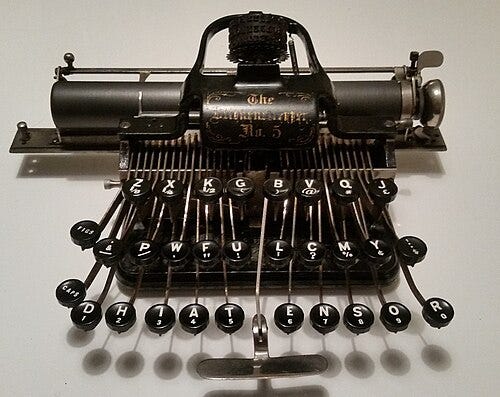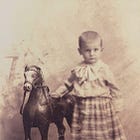A Boy Named Virgil, Part 4: Reverend Throckmorton and the Blickensderfer Typewriter
Tales from a Small Village in Southern Illinois Circa 1900
A Boy Named Virgil is the first-person account of Virgil Bravard Browne, based on a letter he wrote to his niece, Marcia Moore Sagebiel, in 1958. The story is edited and read by me, his grandnephew. Read the introduction.
The parlor was reserved for guests, such as visiting relatives and our Baptists who were called for revival meetings and conference meetings.
I recall one visiting minister named Throckmorton, who I am sure was English by birth, for he had a very clipped manner of speaking, which could not be readily understood by us natives. I overheard one good parishioner grumble that they should not call in “furriners” who could not speak our language understandably. No doubt he spoke far better English than we did, and that was why we failed to get his meaning.
Reverend Throckmorton had a typewriter, the first one I had ever seen. Its name was “Blickensderfer” and was about the size of a modern portable. It had a three-bank keyboard, and the type leaped forward like a striking snake to brush a small felt roller impregnated with ink and then striking the paper, making a rather messy imprint upon it.
It evidently was difficult to apply the correct amount of ink to make the type distinct without being smeared.
The reverend wrote his sermons on the typewriter using the “hunt and peck” system, for I very much doubt if a touch system had been invented at that time.
I drooled to have a chance to use that typewriter, but the minister carefully locked the case when he was through with it. My grandfather would have soundly warmed me if I had been caught fooling with it, so I guess it was best he did lock it.
Blickensderfer Typewriters
The Blickensderfer typewriter was patented by George C. Blickensderfer in 1892, the same year Virgil Bravard Browne was born in Noble, Illinois.
The typewriters, portable and lightweight, were first made in a rented factory in Stamford, Connecticut. They soon became the world’s best-selling typewriters. The company grew to employ 200 people and build 10,000 typewriters annually. The popular Model 5 cost $35.
George Blickensderfer died in 1917, and the factory shut down in 1919. The company’s assets were acquired by the Remington Typewriter Company.
The other furniture in the parlor was a bureau made of walnut with carved drawer pulls, and a combination bookcase and desk made of oak, the most modern piece of furniture in the house.
The bookcase had a glass door, and on its shelves reposed Pilgrim’s Progress, The Sermons of Dwight Moody, Dante’s Inferno, Milton’s Paradise Lost and Paradise Regained (these last three belonged to my father), Tennyson’s poems, and the works of Lord Byron and Sir Walter Scott.
The bottom shelf was occupied by a cardboard box containing a few Christmas cards and penny Valentines saved over the years.
“My grandparents’ home became a permanent home for me.”
— A BOY NAMED VIRGIL, PART 1
Our other literature consisted of The Ram’s Horn (a Baptist publication), The Christian Herald, The Cincinnati Enquirer, a semi-weekly, and the Cincinnati Post, a daily, and taken for the stock market information (hogs and cattle).
These publications, in addition to The Pilot, our local weekly later renamed The Noble News, was our entire stock of reading matter. You can be sure all were carefully read by all members of the family, especially the local paper, for it was a small, tight-knit community.
Not to know of the births and deaths of the local people, as well as the state of health of their livestock, was unthinkable.
Thank you for reading. If you liked this slice of FRIED BOLOGNA, please click the 🤍. Access the archives.






Good they came with cases.
How I feel for Virgil, longing to try the reverend’s typewriter!